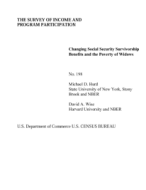Changing Social Security Survivorship Benefits and the Poverty of Widows
Changing Social Security Survivorship Benefits and the Poverty of Widows
Introduction
Survivorship benefit is a feature of most public pension systems. In the United States a widow can receive Social Security benefits following the death of her husband even though she may not have made contributions to the Social Security system during her lifetime. Such a benefit is based on her deceased husband's record of contributions to the Social Security system. The survivor's Social Security benefit is determined by a complex set of rules. A 33 percent reduction in the prior couple's benefit is typical. There is no reason, however, to believe that this reduction is optimal. It is not based on a theoretical principle or on empirical findings. We consider in this paper how changes in U. S. Social Security survivorship benefits might be expected to change the income and poverty rate of surviving spouses and of prior couples. We focus on widow's because they comprise more than three-fourths of elderly nonmarried persons in the U.S.
In principal, a widower can receive benefits based on his deceased wife's earnings record, but in practice this is quite rare because usually his benefit based on his own earnings record will be higher than his widower's benefit, and he is entitled to the higher benefit. For this reason, we shall often refer to the survivor's benefit under the U.S. Social Security system as a widow's benefit.
Although the Social Security benefit can fall by as much as 50 percent at the death of the husband a decline of about one-third is typical. For example, using the Retirement History Survey, Hurd and Wise [1989] calculate that the average Social Security wealth (the expected present value of Social Security benefits) of couples and surviving spouses among families in which the husband died between 1975 and 1977. The average wealth of the couples was $63.7 thousand in 1975. The average Social Security wealth of the surviving spouses was $40.4 thousand in 1977. This implies a reduction in Social Security income of about one-third.
Social Security is the most important component of the income of most elderly families in the United States. In 1988 Social Security benefits were 45.9 percent of the income of elderly unmarried women (Grad, 1990). One-third of unmarried women relied on Social Security for at least 90 percent of their income; 20 percent had income only from Social Security. It is not surprising, therefore, that the drop in Social Security benefits at the death of the husband could have large effects on the economic status of the surviving widow, particularly those at the lower end of the income distribution, and that the incidence of poverty would be high among elderly widows.
In the United States a single elderly person is said to be "in poverty" if his or her income is below the poverty line, $5674 in 1988 ($6729 in 1992). In 1988, 21 percent of nonmarried elderly women lived in poverty, and 34 percent had incomes less than 125 percent of the poverty line. The poverty rate depends on living arrangements and age. Among women 85 or older who were not living with family members the poverty rate was 28 percent. In contrast, the poverty rate of couples aged 85 or over was just 6 percent.
Panel data show clearly that the transition to widowhood increases poverty substantially. Table 1, taken from Hurd and Wise [1989], shows the poverty rates of couples in which the husband survived between 1975 and 1977 and of couples in which the husband died between 1975 and 1977. In 1975 the poverty rates were about the same, but in 1977 the poverty rate of the surviving widows was 42 percent. Even among couples with incomes above the poverty line in 1975, the poverty rate of the surviving widow was 37 percent in 1977 (fourth column of table 1). These result, that are representative of the transitions over other two-year periods, show that the high poverty rates of widows are not just due to widows being the long-lived survivors of the household; the transition to widowhood is, itself, associated with an increase in poverty rates. The issue is discussed also by Holden, Burkhauser and Feaster [1988].
The difference between the poverty rates of elderly widows and elderly couples, and the importance of Social Security benefits to widows suggest that a restructuring of benefits could have an important effect on poverty. An increase in the widow's benefit financed by a reduction in the couple's benefit -- so that expected costs are unchanged -- could reduced the poverty rate of widows in a material way, possibly without increasing substantially the poverty rate of couples. Indeed, such as restructuring could increase aggregate economic welfare.




